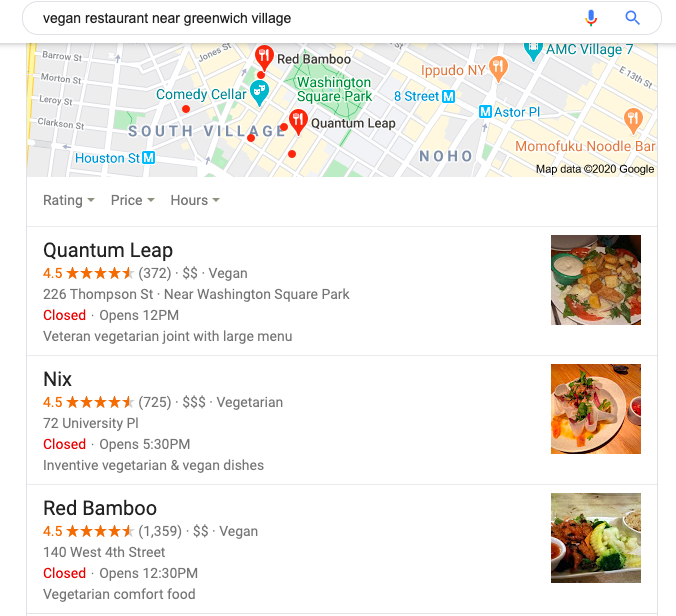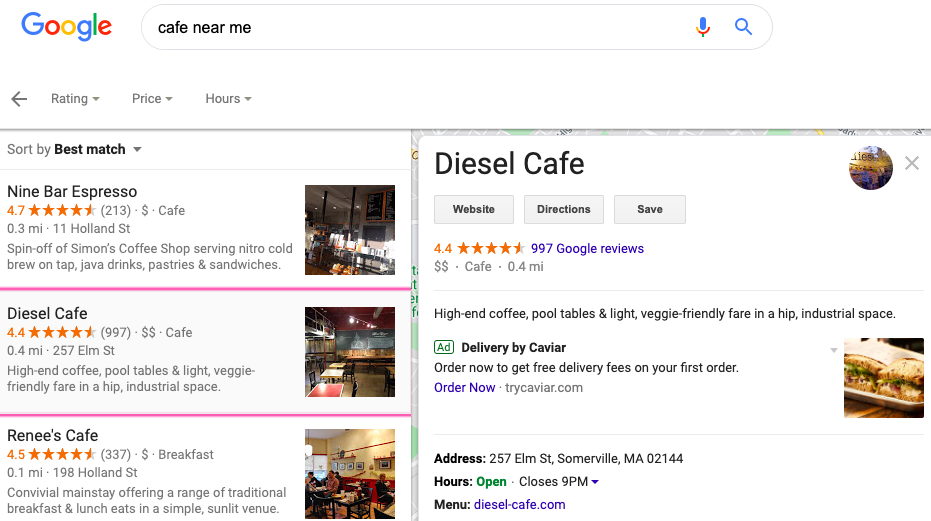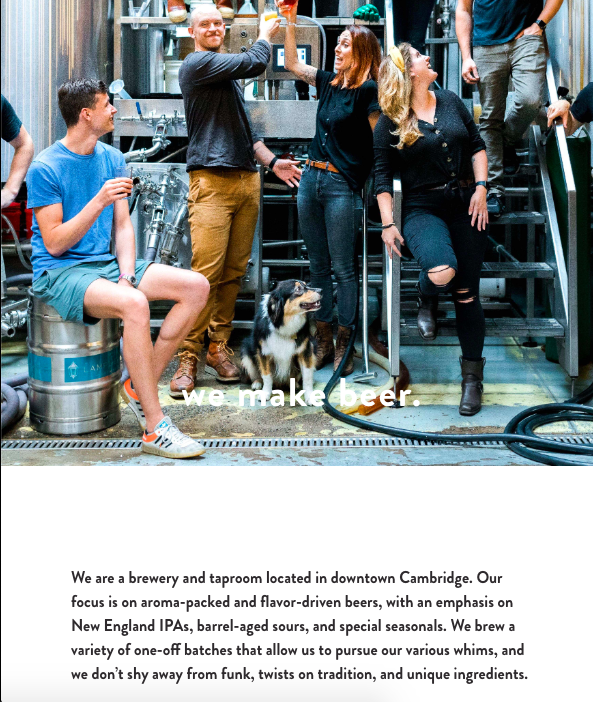A couple of weeks ago, I was planning a trip to New York. I'd never been, so I was excited to start planning and figure out my itinerary.
Once my hotel room was booked, I started looking for things to do during my time. I wanted to stay close to my hotel so I could find my way back after a long day of exploring. This goal of mine meant that most of my Google searches would have "near greenwich village, NY" in the queries.
When I was planning out places to get food, for example, my query was "vegan restaurant near greenwich village". The results Google picked for me based on this search weren't by guessing or magic — most likely, the restaurants used hyperlocal marketing efforts to optimize their businesses for "near me" searches.

Hyperlocal marketing targets audiences who have similar researching methods to mine — those who use "near me" in search queries in hopes of picking out a business to try out in person based on the business's location.
For my New York trip, I didn't want to spend a lot of time commuting, so finding places near my hotel was essential. I knew I was going to see a Broadway play during my trip, and I found similar results for "shopping near broadway".
If your business is struggling locally, or you're looking for a way to boost foot traffic, you may benefit from hyperlocal marketing. Here, let's explore what hyperlocal marketing is, how you can implement hyperlocal marketing at your own company, and examples of hyperlocal marketing to further understand why it matters.
What is Hyperlocal Marketing?
Hyperlocal marketing is a method of marketing that focuses on a targeted audience within a local area. This tactic zeroes in on a small number of consumers who want to buy from businesses near them.
Hyperlocal marketing accomplishes one main goal: raising foot traffic to a store's physical location for people who rely on "near me" queries for shopping.
For example, if I wanted to find a coffee shop in my area, I would Google "coffee shops near me" to figure out where the nearest one is. Any coffee shops that has teams are using hyperlocal marketing as a strategy would then pop up on the results page.
Hyperlocal marketing is a good choice for you if you want to increase in-person sales and boost brand awareness. Next, let's talk about some strategies that'll impact your hyperlocal marketing results.
Hyperlocal marketing strategies
These marketing strategies contribute to the goal of getting more local audiences to find your business from a simple Google search. Although they're focused on hyperlocal results, you can also use these strategies to make sure your business is optimized for online search in general.
1. Make and Optimize Your Google My Business Listing
If your business isn't set up on Google My Business, that's an important first step. Google My Business is the aptly-named tool businesses use to show up on "near me" search queries. When you make your listing, or if you already have one, it's critical you properly optimize the page to show up on search results for "near me" queries.
Some things to keep in mind: add relevant keywords in your business description to increase your chances of being found. Make sure you post high-quality photos to make your listing professional. Additionally, increase your visibility by choosing categories that best describe your business and business goals.
Google My Business queries' most fundamental element is location, so your optimization efforts should focus on that. When you optimize your listing, you raise your chances of being ranked highly on local results pages.
2. Make Sure You're Accessible
On your website, make your contact information easy to find. It should be labeled clearly on your webpage. This tells customers your business is accessible and welcomes interaction.
If you have business pages on social media platforms, be sure to link back to your website, provide your store location, and include contact information as well. As a consumer, I find most new local restaurants on social media — if I can't contact them about my dietary restrictions, I won't make a reservation.
If your business is near any popular landmarks or attractions, you can note them in the description of your business to draw in customers who are looking for businesses near attractions. Those keywords will expand your reach.
3. Optimize For Local Search
Review your website. When was the last time it was optimized for SEO? Your website should be optimized to the same standards your Google My Business page is.
Let's go over what it means to have your website properly optimized. First, it should be easy to navigate, so first-time visitors can find their way around.
Next, your URL structure should be informative. Google sees URLs first and asks questions later, so the information in your URL should be relevant to search queries. If your business provides marketing solutions in Las Vegas, for example, one of your website pages should have a URL structure that includes the keywords "marketing company," and "Las Vegas".
After checking URL structure, be sure to check the language on your website. It should emphasize the locality of your business. What helps with this is using hyperlocal keywords, like nearby landmarks or popular tourist destinations near your business.
When you use hyperlocal keywords on your site, have a local-based website structure, and keep your website properly optimized for SEO, you increase the chances of locals and tourists finding your business on Google.
4. Create Content That's Hyperlocal
In the same notion of making language on your site hyperlocal, take it a step further and make content that's hyperlocal. Small businesses whose teams turn to a local marketing plan have the advantage of leveraging content ideas that center around locality. Local content can increase the rank you have on pages that concern location.
How do you come up with local content? Think about your current strategy, what you're doing now, and how you can put a local spin on it. If your highest-performing content is already focused on location, see how you can modify previous or upcoming content to do the same.
Additionally, local businesses can make content about local events, like a city-wide festival or pop-up shop. You could write a short blog post about the history of a local festival, or take pictures of your business participating in a local networking event for social media.
Most content ideas you have, you most likely won't have to modify that much, especially if they're performing well with audiences.
Now, let's look at some examples of companies whose online presence is benefitting from hyperlocal marketing content.
Hyperlocal marketing examples
1. Diesel Cafe
Let's look at an example of an awesome Google My Business page. Remember, Google My Business pages helps those who turn to Google first to find local spots near them. So when I typed in "cafe near me" as a search query, this is what I saw:

Let's talk about why this example is awesome.
First, the most important details are listed: the company address, menu, contact information, and website. If I were to click on the website or the menu, all of the links work, making this listing accessible and comprehensible.
There are also plenty of photos, from customers and business owners, to establish the vibe the cafe has from the inside to the outside. Additionally, look at the rating and amount of reviews: I could pour over almost 1,000 reviews if the 4.4 stars didn't convince me at first glance.
Diesel Cafe excelled at hyperlocal marketing here because their page is properly optimized for hyperlocal marketing. The biggest clue is that it was one of the first results when I typed in my search query. To test the quality of your page, see if you can use a vague search query, like "cafes near me," to find it.
2. Lamplighter Brewing Co.
For this example, let's look at an optimized website.
Boston-based brewery Lamplighter Brewing has been filling the glasses of locals and visitors alike since 2014. Lamplighter is very successful at hyperlocal marketing and their website reflects how dedicated they are to providing visitors with an experience that keeps Boston at the forefront.
For instance, let's look at Lamplighter's "About" page. As a first-time visitor, I'd be looking for local language, such as location, and business hours in the location's time zone. I'd also be looking for services and local flair to help make my decisions.

From the "About page," I can see the brewery's location, services offered, a business goal of sticking to New England IPAs, and what makes the brewery different from other options in the area. This is a wonderful example of a business page that was optimized using hyperlocal strategies, like location, and the business's local ties.
Because of their optimized website, when I search "craft beer in cambridge mass" in Google, I could find Lamplighter in the first five results, with their website listed on Google.
3. Glossier
Here's an example of hyperlocal marketing by a global company. Beauty company Glossier opened a pop-up location in Boston's Seaport area during 2019. To market their new pop-up, Glossier used a lot of Boston-based hyperlocal marketing efforts to build interest with a specific audience: Boston-based customers who could travel to Seaport.
Let's look at their Instagram ad:
This post was uploaded three days after the New England Patriots won Super Bowl LIII. The location of the image? A public transit stop less than ten minutes away from the location of Glossier's pop-up.
The image shows the middle of Super Bowl festivities, sure, but it also shows an ad for a Glossier product. The marketers at Glossier saw a golden opportunity to boost local interest by showcasing their ad and how locals interact with it during a massive local event.
4. Dollop Coffee Co.
Hyperlocal marketing on Twitter? Chicago-based coffee chain Dollop proves it's possible. From their bio, which includes local language and contact information, to their tweets, which have a theme of slipping location into most of them, it's clear Dollop uses Twitter to target and engage with local audiences.
For instance, check out their pinned tweet from December 2019:
Hey what are you up to Thursday? Nothing? Cool- a new new Dollop opens @ 4613 N Lincoln, serving our Dollop Diner Breakfast sandwiches, fancy coffee dranks and our new “healthy chocolate shake” smoothie. See you @ 7am! pic.twitter.com/s45OD9BnA6
— Dollop Coffee Co. (@DollopCoffeeCo) December 12, 2019
This tweet gives the hyperlocal marketing essentials: location, cool features, a peek at the store's hours, and high-quality photos. If I were visiting Chicago and came across this tweet, I could easily copy and paste the address in my search bar.
To check and see if Dollop's hyperlocal Twitter strategy was working, I searched "coffee chicago" on Twitter, and clicked on the "People" section. Dollop's account is in the top ten results. For such a vague search query, it's clear to see that Dollop's strategy is paying off.
Now that we've gone over some hyperlocal strategies and examples, you're ready to start planning how to effectively implement a hyperlocal plan for your business. To see how your business ranks hyperlocally, start with search queries. Type in "near me" queries and see what businesses ranking above yours are doing to improve their ranking.
Will I see your business next time I'm traveling and looking for places "near me"?
No comments:
Post a Comment